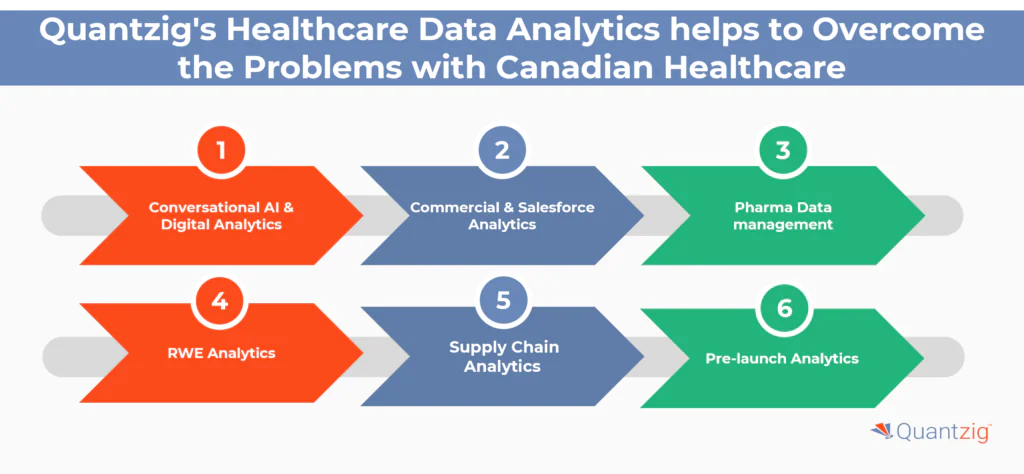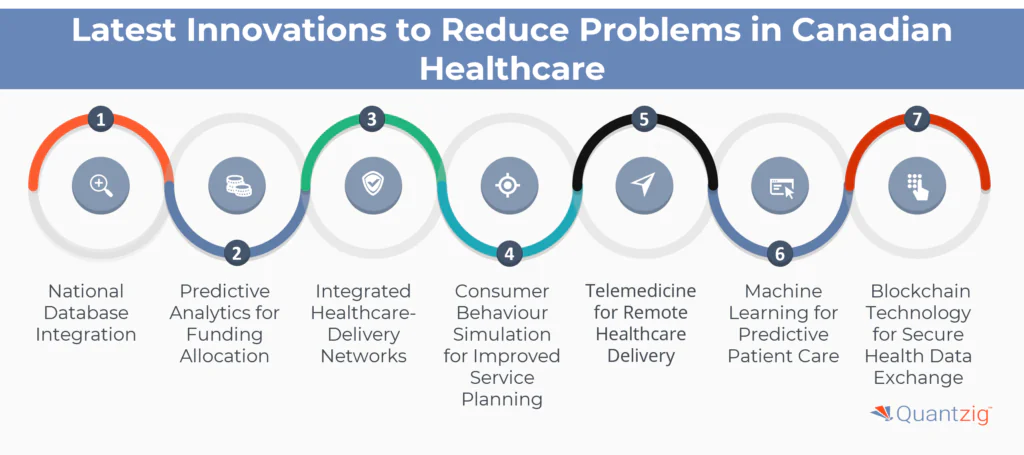Author: Associate Vice President, Analytics and Data Strategy, Quantzig.
The Canadian healthcare system is complex, but it’s built on the basic principle that focuses on providing healthcare access based on need rather than the ability to pay. The Canadian healthcare system deploys decentralized administration and service delivery systems that are accessible to all groups of people. However, despite the pros like universal accessibility and special care for special needs, the Canadian healthcare system is facing several obstacles due to changing healthcare landscape in the aging society.
You may think, then what might be the solution to this rising issue? Services like Quantzig’s healthcare analytics services are the key to propel the solutions by streamlining these hurdles, offering data-driven insights that can enhance decision-making, optimize resource allocation, and ensure that healthcare providers effectively meet the demands of an aging society.
Our smart analytics solutions have helped many healthcare players. Book a demo to experience the meaningful insights we derive from data through our analytical tools and platform capabilities.
Request a demo nowTable of Contents
Problems with the Canadian Healthcare System
The Canadian Medicare system, while universally accessible, faces significant challenges that impact its efficiency and effectiveness. Key issues include long waiting periods, unrealistic fees, and limited accessibility in rural areas, all of which hinder the delivery of timely and equitable healthcare services.
| Issue | Description | Impact |
|---|---|---|
| Long Waiting Periods | High patient numbers lead to extended wait times for non-urgent procedures like joint replacements and specialist consultations. | Delays can escalate non-emergency situations to life-threatening levels, causing frustration among patients. |
| Unrealistic Fees | Mandated fees often do not cover the costs for healthcare providers, making the system financially unsustainable. | Leads to financial strain on healthcare providers and can burden taxpayers, threatening the system’s viability. |
| Accessibility in Rural Areas | Funding is based on location and demographics, leaving sparsely populated areas with fewer resources and inadequate healthcare services. | Residents in rural areas face difficulties in accessing adequate healthcare, often needing to travel to cities. |
Experience the advantages firsthand by testing a customized complimentary pilot designed to address your specific requirements. Pilot studies are non-committal in nature.
Request a free pilotHow can Quantzig’s Healthcare Data Analytics help to Overcome the Problems with Canadian Healthcare?
The Canadian healthcare system faces numerous challenges ranging from escalating costs and resource constraints to inefficiencies in care delivery. To address these complexities, organizations need innovative solutions that can harness the power of data to drive actionable insights and enhance decision-making. This is where Quantzig’s Healthcare Data Analytics solutions come into play. With a proven track record of empowering healthcare organizations worldwide, we offer tailored analytics solutions like streamlined patient management, designed to tackle the Canada’s Healthcare Challenges.
1. Conversational AI & Digital Analytics
Utilizing a conversational bot powered by AI technology enables healthcare providers to engage with patients and physicians promptly, addressing their queries efficiently and improving overall satisfaction. By leveraging automated data-backed notifications, organizations can enhance customer acquisition and retention strategies effectively. Additionally, brand value quantification methodologies allow stakeholders to measure and benchmark their brand perception against competitors, identifying areas for improvement and strengthening their brand value proposition. Sentiment analysis techniques further refine brand messaging by understanding physician and patient sentiments, enabling organizations to emphasize strengths and counter competitor perceptions effectively, thus enhancing brand positioning and market competitiveness. This might involve periodic adjustments to fees based on economic factors and the evolving healthcare landscape.
2. Commercial & Salesforce Analytics
Marketing analytics involves evaluating the current return on investment (ROI), strategically reallocating funds through intelligent simulations, and optimizing creative content to resonate with the target audience effectively. Salesforce analytics focuses on establishing the appropriate size for the salesforce, ensuring optimal operations, minimizing the impact of vacancies, and tracking and enhancing performance through well-defined plans. Physician analytics aims to identify influential healthcare professionals (HCPs) within the network, potential points of churn, and determining the next best action to improve retention and increase revenue. By leveraging these analytics strategies, organizations can make data-driven decisions, enhance operational efficiency, and drive growth across marketing, sales, and healthcare sectors.
3. Pharma Data management
In cloud strategy development, we assist in analyzing data maturity, mapping data sources, and quantifying business objectives to formulate an effective roadmap for data strategy. Our knowledge repository build service establishes a centralized platform for accessing data across sources in just five steps, accelerating the time to actual analytics. Additionally, our data quality management framework ensures high-quality data by automatically correcting 90% of data issues, enabling businesses to have readily available and reliable data for analysis in near-real-time. Through these services, we empower organizations to leverage their data effectively, drive informed decision-making, and achieve their strategic objectives with confidence.
4. RWE Analytics
Through patient journey maps derived from evidence data, we pinpoint the next-best actions for patient acquisition and retention, enhancing overall patient care and satisfaction. Our patient care analysis facilitates easy access to understand patient life stage value, enabling identification of drivers behind inflated costs for patient cohorts, thereby streamlining healthcare processes and optimizing resource allocation. Additionally, our medical insight analysis identifies critical medical insights and gaps in diagnosis and treatment portfolios, allowing for refinement of brand messages based on conversations between Medical Science Liaisons and Healthcare Providers (HCPs), ultimately improving communication and effectiveness in the healthcare ecosystem.
5. Supply Chain Analytics
Utilizing advanced forecasting techniques, we accurately predict drug demand and asset requirements, ensuring a seamless supply chain manufacturing experience. With manufacturing analytics, we optimize production output, simulate updated plans for real-time constraints, and effectively plan Bill of Materials (BoM) requirements to minimize Microstops and enhance operational efficiency. Furthermore, our distribution network optimization strategies expedite delivery while minimizing costs through the optimization of distribution networks and warehouse planning, ensuring timely and cost-effective delivery of pharmaceutical products to patients and healthcare providers.
6. Pre-launch Analytics
Our comprehensive solutions encompass dose escalation digitization, which centralizes testing processes, facilitates data-driven decision-making based on historical evidence, and enhances transparency while enabling cross-test comparisons. Additionally, our decision support and target identification solutions expedite and refine the process of identifying targets for upcoming clinical trials, enhancing accuracy and efficiency. Moreover, our in-silico clinical trial simulations maximize the success rate of clinical trials by identifying optimal treatment pathways, identifying the problems in Canadian healthcare, thereby streamlining the drug development process and improving patient outcomes.
Quantzig’s Healthcare Data Analytics solutions offer a transformative approach to overcoming the challenges plaguing the Canadian healthcare system. By leveraging advanced analytics techniques and cutting-edge technologies, we enable healthcare organizations to unlock the full potential of their data, driving operational efficiencies, improving patient outcomes, and ultimately, delivering value-based care. With Quantzig as a trusted partner, Canadian healthcare providers can navigate the complexities of the modern healthcare landscape with confidence, paving the way for a healthier and more sustainable future.
Get started with your complimentary trial today and delve into our platform without any obligations. Explore our wide range of customized, consumption driven analytical solutions services built across the analytical maturity levels.
Start your free trial nowLatest Innovations to Reduce challenges of canadian healthcare system
Canada’s healthcare system faces numerous challenges, ranging from rising healthcare spending and inflation to issues with data management and population growth. However, innovative solutions leveraging analytics and advancements in health information technology offer promising avenues to address these challenges of Canadian healthcare system and improve the overall efficiency and effectiveness of the healthcare system.
1. National Database Integration
Leveraging advanced analytics and health information technology, the Canadian Institute for Health Information is spearheading efforts to integrate cross-country health data into a comprehensive national database. This initiative aims to address the issues in the Canadian healthcare system and the data problem by providing healthcare stakeholders with access to standardized, real-time data for improved decision-making and performance accountability. By centralizing health data from various sources, including individual patient care records and population health statistics, this innovation enables comprehensive insights into Canada’s health status and healthcare system performance.
2. Predictive Analytics for Funding Allocation
Another innovative approach involves the use of predictive analytics to optimize healthcare funding allocation. By analyzing healthcare spending trends, population growth projections, and inflation rates, Canadian government agencies can make data-driven decisions to allocate funding increases where they are most needed to deal with the issues in the Canadian healthcare system. This proactive approach not only ensures efficient resource utilization but also fosters performance accountability by aligning funding allocations with healthcare outcomes and population health needs.
3. Integrated Healthcare-Delivery Networks
Recognizing the need for a more coordinated and efficient healthcare delivery system, Canadian healthcare authorities are implementing integrated healthcare-delivery networks. These networks leverage enterprise data architectures and online analytical processing (OLAP) tools to streamline operations, improve planning capabilities, and enhance decision support at both organizational and systemic levels. By integrating data from various sources, including electronic health record systems and national health databases, healthcare organizations can achieve greater efficiency, reduce wait times, and improve patient care quality across the country.
4. Consumer Behavior Simulation for Improved Service Planning
With the advent of sophisticated analytical resources and business intelligence technology, healthcare organizations are now employing consumer behavior simulation models to inform service planning and resource allocation decisions. By analyzing genomic, cultural, social, and economic factors, these models provide insights into patient needs, preferences, and behaviors, enabling healthcare providers to tailor services and interventions to meet individual and community health needs effectively. This strategic approach not only enhances the standard of care but also addresses health inequities and fosters value-based healthcare delivery nationwide.
5. Telemedicine for Remote Healthcare Delivery
In response to staffing shortages and the need for universal access to healthcare, Canadian healthcare organizations are increasingly adopting telemedicine solutions. These platforms leverage e-health initiatives and electronic health record systems to facilitate remote consultations and monitoring, overcoming geographical barriers and improving access to care for patients in underserved areas. By harnessing high-quality information and decision-making tools, telemedicine enables front-line healthcare practitioners to deliver timely and efficient care while reducing the burden on traditional healthcare facilities.
6. Machine Learning for Predictive Patient Care
With the rise of analytical resources and complex system analysis, healthcare providers are embracing machine learning algorithms to enhance evidence-based healthcare delivery and patient outcomes. By analyzing vast datasets encompassing individual patient care histories, cross-country health data, and genomic factors, these algorithms can predict disease progression, identify at-risk populations, and recommend personalized treatment plans. This data-driven approach not only improves quality of care but also empowers healthcare professionals to deliver value for money and address evolving health needs effectively.
7. Blockchain Technology for Secure Health Data Exchange
To address data quality problems and enhance data security in healthcare, Canadian organizations are exploring blockchain solutions for health data management. By establishing national databases and health authorities powered by blockchain technology, stakeholders can ensure the integrity and confidentiality of health information while enabling seamless interoperability and data sharing across federal and provincial jurisdictions. This innovative approach fosters performance accountability and transparency while mitigating the risks associated with fragmented data sources and limited data accessibility.
Innovations in analytics and health information technology offer promising solutions to address the challenges facing Canada’s healthcare system. By leveraging national database integration and predictive analytics for funding allocation, healthcare stakeholders can enhance data-driven decision-making, improve resource allocation efficiency, and ultimately, advance the overall quality and accessibility of healthcare services across the country.
Conclusion
In conclusion, tackling Canada’s healthcare crisis requires a comprehensive and collaborative effort. Policymakers, healthcare providers, and the community must work together to implement reforms that prioritize patient well-being, address financial sustainability, and ensure equitable access across all regions. By embracing innovation, revisiting fee structures, and investing strategically, Canada can build a healthcare system that meets the diverse needs of its population while maintaining the principles of universality and accessibility.






